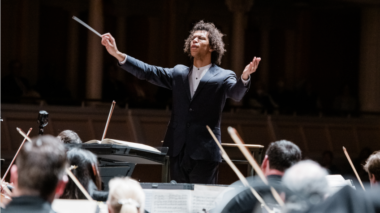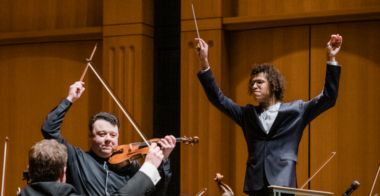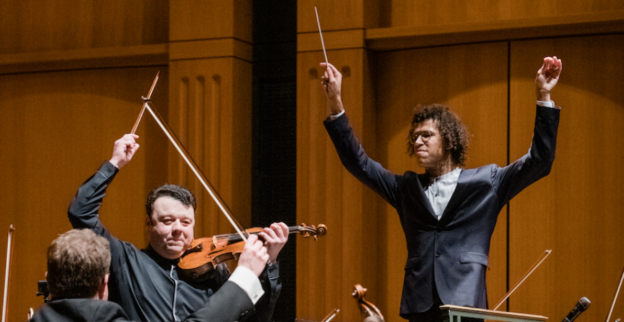 United States Price, Beethoven, Tchaikovsky: Vadim Gluzman (violin), Charleston Symphony Youth Orchestra [for the Price], Charleston Symphony Orchestra / Jonathon Heyward (conductor). Gaillard Hall, Charleston, South Carolina, 7.1.2023. (LV)
United States Price, Beethoven, Tchaikovsky: Vadim Gluzman (violin), Charleston Symphony Youth Orchestra [for the Price], Charleston Symphony Orchestra / Jonathon Heyward (conductor). Gaillard Hall, Charleston, South Carolina, 7.1.2023. (LV)

Price – ‘Dances in the Canebrakes’ (orch. William Grant Still)
Beethoven – Violin Concerto in D major, Op.61
Tchaikovsky – Symphony No.6 in B minor, Op.74, ‘Pathétique’
Jonathon Heyward, newly anointed as music director of the Baltimore Symphony, was greeted with warmth and energy, cheers and whistles when he came out on the Gaillard Hall stage to conduct the Charleston Symphony for the first time, an authentic hometown hero. When he turned around to lead the audience in the ‘Star-Spangled Banner’, it seemed like everybody in the sold-out hall was singing with a full-throated musicality that made this one of the best performances of the anthem I had ever heard.
From the first bars of Florence Price’s 10-minute ‘Dances in the Canebrakes’ in William Grant Still’s colorful orchestration, Heyward elicited detail while maintaining momentum and showed great tempo choices, always organic and natural. The clarity and precision of his conducting was reflected in the exuberant playing by the combined forces of the Symphony and the Youth Symphony, in which Heyward had once played cello. He was keen on articulation and integrated small bits into the whole without ever seeming rushed. With his back to the audience, he monitored the proceedings with marionette-like moves on the podium.
Heyward began the Beethoven Violin Concerto two-to-a-bar at a nice speed which gave the opening tutti a gently flowing, lyrical quality. With its sense of anticipation and restrained passion, the performance of the orchestra tutti was more than mere accompaniment. When Vadim Gluzman entered with his marvelous Strad (the ‘ex-Leopold Auer’ 1690), they immediately caught the speed and flow and with exceptionally phrased rubato, never drawing attention to the soloist and always expanding the musical dimensions. The last statement by violin through the triplets to the big striding climax was very moving, and Gluzman’s legato runs were mesmerizing. Entering the cadenza, a sense of personal chemistry between soloist and conductor infused the music with a special warmth.
It is unlikely that Alfred Schnittke’s five-minute cadenza, written for Gidon Kremer and running the gamut from Bach to Schnittke with hints and teases of Beethoven, Brahms, Mozart, Ysaÿe and Schoenberg, will supplant Kreisler or Joachim until perhaps Spock’s voyages on the starship Enterprise, and it certainly has no intention of being integral to the concerto, but the opportunity it gave Gluzman to dig into his violin expanded the dimensions of the concerto’s universe.
The Larghetto began with the kind of ghostly, muted pianissimo that requires a conductor who really wants it. The orchestral passage leading to the violin’s second entrance was simple and eloquent, the passage with the orchestral pizzicatos, usually a reflective moment, was almost lighthearted. The Gaillard Hall had just the right amount of resonance, and you could hear the subtlest nuances of Gluzman’s playing.

After Schnittke, Beethoven’s brief cadenza adlib transition to the Rondo finale seems unnecessarily tame, but Gluzman played the main tune, which in recent years has tended to be peppy and cheerful, with loving intimacy, transforming it into something so tasty that I wanted to hear it again and again. As the movement proceeded, studded like jewels with gorgeous duets between Gluzman and new principal bassoonist, Jordan Brokken, Heyward continued to unobtrusively nail all of the pivot points on which the piece depends, including a miraculous return to Beethoven from the world of Schnittke.
Heyward generally prefers not to speak to audiences about the music he is playing, but he made an exception for the Tchaikovsky. After beginning with ‘Boy, it’s nice to be home’, he talked briefly about the ‘the human connection’. It was a nice touch but, in fact, the performance he and the Charleston Symphony gave brought home the universal implications of both the composer’s exhilaration and his despair. In the opening Adagio, the almost inaudible basses set the stage for the iconic bassoon solo, played magnificently by Brokken. Once the Allegro non troppo was underway, Heyward transitioned to the big second theme, holding back just enough to create anticipation. The last return of the famous theme, disturbed only momentarily by a cough in the audience, was devastating in its sad beauty.
The Allegro con grazia had a graceful lilt, Heyward playing with the unorthodox five beats to a bar meter, and the tendrils at the end changing from 3/2 to 2/3 were unusually touching. The Allegro molto vivace, which marched along as ferociously as ever, and the long crescendos, taut and fraught with ominous overtones, elicited the usual applause out of which Heyward launched the Allegro lamentoso with a brilliant sense of timing, making sure the essential first note was heard, reflecting his love of opera. In fact, prior to Charleston, he had ended the year conducting a concert performance of Aida at the Detroit Opera. After the simplicity of Tchaikovsky’s despair and the dying away of the heartbeats in the bass at the end, Heyward let the final notes linger for a full 20 seconds before letting go.
In an interview earlier in the day, Heyward told me he wanted to make his homecoming ‘very community oriented’, and he started off by giving a masterclass in conducting to music educators. ‘I wanted to make sure I was able to say thank you to the people that got me to where I am today. I also really wanted to reach out to youth orchestras’.
Heyward admitted that he used to skip school to sit in at Charleston Symphony Orchestra rehearsals. ‘I’d be this kid with a full score in the back, right behind the cellos, literally writing down every single thing in a notebook I still have that conductor David Stahl said’. Heyward has all the rehearsal notes: ‘That’s how I learned, absorbing the music for years as a high schooler. It was amazing’.
The Charleston Symphony has a core of 24 players, augmented as necessary from a regular roster of outstanding freelancers. ‘It’s incredibly impressive what they’re able to achieve’, Heyward told me. And there is a significant difference for a young conductor on the rise who has been guesting all over the world. ‘I hardly ever know anyone’s name in these orchestras. Here in Charleston, I know every single musician. To be able to say to [concertmaster and artistic advisor] Yuriy Bekker, “I want a little bit more of this”, or to bassoonist Kathy St. John, “Can we come in more slowly here?”, is special’. In fact, it was St. John who gave the young note-taking Heyward a present of the full score of Tchaikovsky’s last three symphonies – which he used for his performances Thursday and Saturday nights.
When I talked to Vadim Gluzman after the concert about the young conductor’s brilliant technique, he said, ‘Of course, everything is technique but technique at the end of the day is secondary, it’s a means of transportation and if you don’t know where to go, you could sit in a Bentley and not get anywhere. You have to have ideas, talent and purpose. And when I met Jonathon for the first time and worked with him this week, I thought, okay, there is a future for classical music’.
Laurence Vittes

This review truly captured the concert. My hope is that the Post and Courier, our Charleston Newspaper, will again hire someone to review our wonderful concerts and theater here in Charleston. The Symphony performs each Masterworks concert on two nights. How wonderful if the citizens of Charleston could have a review to encourage those who don’t already have tickets to get them for the second night. The reviews were always an important part of the Spoleto Festival experience. But they have not had a reviewer for at least 5 years or more.